
Hard charging tesla goes coast-to-coast stations next year.
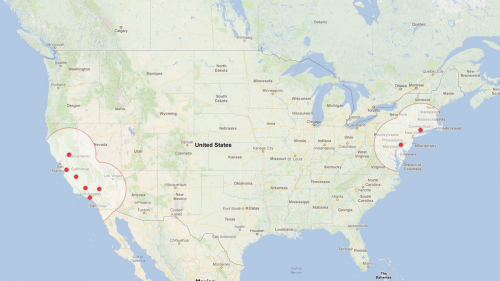 the network right now | red (installed) grey (coming) | maps courtesy tesla
the network right now | red (installed) grey (coming) | maps courtesy tesla
In promoting what he claimed to be a national network of “superchargers” for his Tesla electric cars, Elon Musk said when the zombie apocalypse comes, you’ll still be able to drive your Model S electric sports sedan coast to coast in the US. Those superchargers with solar panels will be off the grid.
The chargers cost an estimated $250,000 apiece—the price of an Aston Martin. The chargers are incompatible with all industry standards and work only with Tesla’s Model S—but they are way faster.
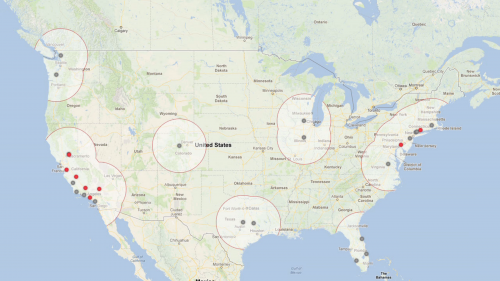 summer 2013
summer 2013
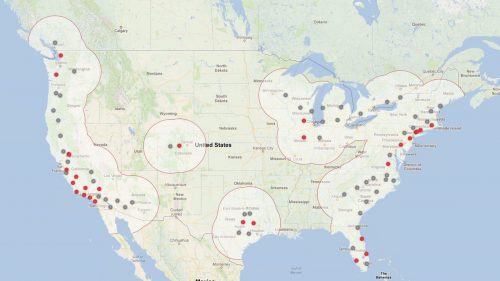 fall 2013
fall 2013
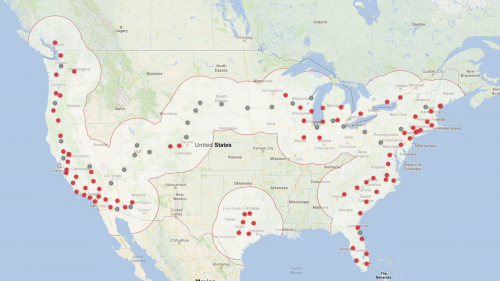 winter 2013
winter 2013
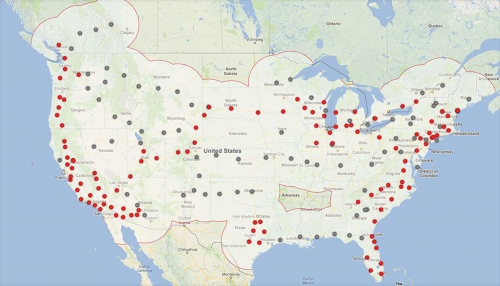 2014
2014
 2015
2015
above> video courtesy of tesla | below> video courtesy of mike anthony autosports
[ official full release ]
Tesla dramatically expands supercharger network, delivery convenient, free long distance driving throughout U.S. and Canada.
MAY 30, 2013 – Tesla Motors (NASDAQ: TSLA) today announced significant expansion of the Tesla Supercharger network. Supercharging enables Tesla Model S drivers to travel long distances, for free, indefinitely.
The expansion of the network builds upon the success of the Tesla Supercharger network that covers California and Nevada on the west coast and the Washington, DC to Boston region on the east coast. The Tesla Supercharger network has enabled an estimated 1 million miles of driving since going live in October 2012. Superchargers are designed for city to city travel, enabling Model S electric vehicle drivers to travel for about three hours, take a 20 to 30 minute break to grab lunch or a soda or coffee, and get back on the road charged up. For free.
With the accelerated rollout of the Tesla Supercharger network, Model S drivers can expect:
> Triple the number of Tesla Supercharger stations by the end of next month, including additional stations in California, coverage of the northwest region from Vancouver to Seattle to Portland, Austin to Dallas in Texas, Illinois and Colorado. There will also be four additional eastern seaboard stations, expanding the density of the network to provide for more convenient stopping points.
> Within six months the Tesla Supercharger network will connect most of the major metro areas in the US and Canada, including expansion into Arizona, additional stations in Texas, Florida, and the Midwest, stations connecting Ottawa to Montreal, and across North and South Carolina into Georgia. It will also be possible to travel diagonally across the country from Los Angeles to New York using only the Tesla Supercharger network.
> A year from now, the Tesla Supercharger network will stretch across the continent, covering almost the entire population of the US and Canada. The expansion of the network will mean that Model S drivers can take the ultimate road trip — whether that’s LA to New York, Vancouver to San Diego, or Montreal to Miami – without spending a cent on fuel.
In addition to the expansion of the Tesla Supercharger network itself, Tesla is improving the technology behind the Tesla Supercharger to dramatically decrease the amount of time it takes to charge Model S, cutting charging time in half relative to early trials of the system. The new technology, which is in beta test mode now and will be fully rolled out to customers this summer, will allow Model S to be charged at 120 kW, replenishing three hours of driving in just over 20 minutes.
[ about tesla ]
Tesla Motors’ (NASDAQ: TSLA) goal is to accelerate the world’s transition to electric mobility with a full range of increasingly affordable electric cars. California-based Tesla designs and manufactures EVs, as well as EV powertrain components for partners such as Toyota and Daimler. Tesla has delivered more than 10,000 electric vehicles to customers in 31 countries.
[ forward-looking statements ]
Certain statements in this press release, including statements regarding future Tesla Supercharger locations, timing and capabilities, are “forward-looking statements” that are subject to risks and uncertainties. These forward-looking statements are based on management’s current expectations, and as a result of certain risks and uncertainties, actual results may differ materially from those projected. Various important factors could cause actual results to differ materially from those in the forward-looking statements, including potential difficulties in finding suitable Tesla Supercharger sites, negotiating leases or obtaining required permits for such locations, as well as the risks and uncertainties identified under the sections captioned “Risk Factors” and “Management’s Discussion and Analysis of Financial Condition and Results Of Operations” in Tesla’s Form 10-Q filed on May 10, 2013. Tesla disclaims any obligation to update information contained in these forward-looking statements.



